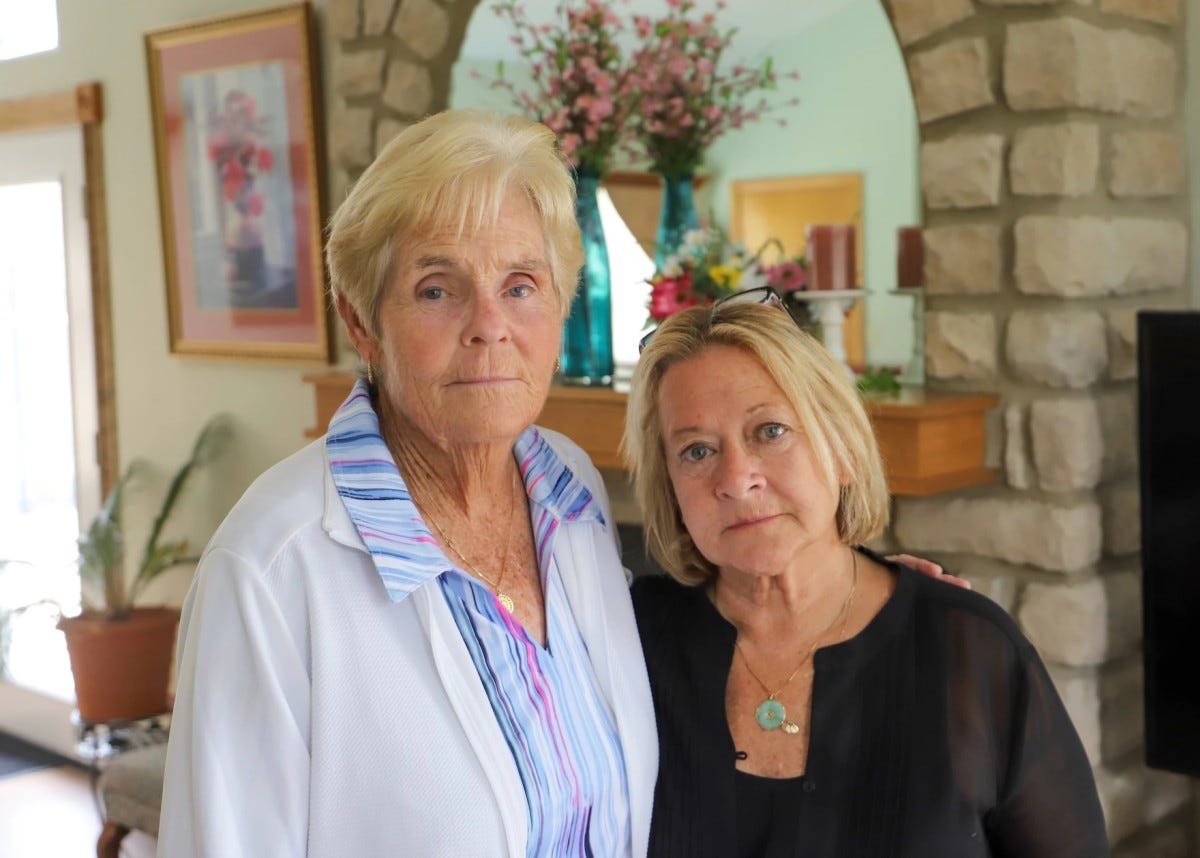Bill Sproat and Mary Petry: 1970 Ohio Murder Case Still Unsolved
One of Ohio's oldest cold cases
Haunting Cold Case
On Friday, February 27th, 1970, 20-year-old Mary Petry arrived at the off-campus apartment of her boyfriend, 22-year-old Bill Sproat, intending to spend the weekend with him. What would soon follow for the couple was unimaginable horror.
The next day, their lifeless bodies would be discovered. Mary and Bill had been strangled and stabbed numerous times. Each had sustained blunt force trauma injuries to the head as well.
Yet no one in the apartment building or surrounding area had heard anything strange that night. The sheer brutality of the crime seemed to suggest that the assailant may have been known to one or both of the victims, but who would have wanted to harm these two quiet, well-liked students remained a mystery.
Despite the recovery of DNA evidence from the crime scene, the case went cold as no solid leads or viable suspects materialized.
Who killed Mary Petry and Bill Sproat?
Mary Petry & Bill Sproat
One of five children, Mary Jane Petry was born on October 12th, 1949, in Portsmouth, Ohio, to parents Paul and Marcella. She shared a close bond with her twin sister Martha.
Mary was highly intelligent, kind, deeply religious, and had a love of the French language and culture. She earned an award for best international student after spending time abroad in the summer of 1968.
In 1970, Mary was a third-year student at Mount St. Joseph in Cincinnati, where she studied French. She and Bill, whom she had been dating for over a year at the time of her murder, had been introduced by a mutual friend.
One of two children, William “Bill” Joseph Sproat Jr. was born in Philadelphia, Pennsylvania, in 1947, to parents William and Mary. Bill, who had obtained a French degree from Xavier University, was doing his graduate studies at The Ohio State University.
Bill was said to be an extremely smart and academically driven person.
“He had all these academic accolades and my parents were very proud of him,” his sister Patricia later said.
She continued:
“He was not a fighter kind of person. He was quiet but fun-loving, very conscientious about his studies, yet not nerdy.”
His classmates recalled him as a “perfectly gentle person and a good serious student.”
He and Mary, two introverts with a shared passion for French culture and language, hit it off immediately.
Martha:
“I knew about Mary’s love for Bill and his love for her. … Mary did not have a doubt in the world about her pathway. She was gonna marry Bill, she was going to teach at one of the Catholic high schools until both of them could go over to France and live their lives.”
The Crime
On the afternoon of February 27th, 1970, Mary got a ride from her university with four other young women. One of them, Terry, said that she and Mary were dropped off at a Holiday Inn in Grove City, where each had plans to be picked up by someone.
Terry’s father, who had arrived to pick her up, felt uncomfortable with the idea of leaving Mary there alone in the lobby, but Mary insisted that she was going to wait for Bill to show up, so they eventually left.
For unknown reasons, Bill never arrived, so Mary had to make other arrangements.
(Note: it has been said that Bill needed to type up a paper that weekend, so it’s possible that he was working on that, but it’s unknown if this is why he didn’t show up.)
She called Bill from Grove City at 5:15 p.m. and told him that she was going to take a cab to his apartment. Bill’s roommate and longtime friend Tom left at approximately 6 p.m. to go stay at his girlfriend’s place.
Oddly, though Grove City is only around 10 miles away from Columbus, Mary wasn’t dropped off by the cab driver until 6:30 p.m. Maybe traffic was congested or it took a while for her to find an available cab.
From here, the sequence of events is a mystery.
None of Bill’s neighbors heard anything that would cause alarm, but they did notice that his door was slightly ajar that evening and heard the sounds of a radio emanating from the dark apartment, but didn’t go inside to investigate.
At 8 p.m. a newsboy showed up to collect money, but didn’t stop by Bill’s place since he wasn’t one of his customers. As he left, he came across a strange man on the front porch. This individual rudely told the boy to “get the hell out of here.” The darkness made it difficult to get a clear look at him; the boy could only say that he believed this man—who has never been identified—was fairly young.
The next day, around 12:30 p.m., Tom returned to the apartment and found a horrifying and bloody scene. Bill and Mary had been killed; he was in the bathroom and she was in one of the bedrooms.
The police were called.
“And what they walked into was just a gruesome, brutal scene,” said Columbus Police Cold Case Detective Sergeant Terry McConnell.
Autopsy Results & Investigation
An autopsy determined that Mary had sustained 23 stab wounds to her back, multiple blunt force trauma injuries to her head—resulting in a fractured skull—and had been strangled. She had a ligature around her neck and scratches around it that indicated a frantic struggle to remove it.
The uniformity of her stab wounds suggested that she was already incapacitated or dead by the time they occurred. Additionally, the lack of internal bleeding around these areas gave credence to the idea that she was already dead by then.
It was unclear if she had been raped, but it's strongly suspected that she was. She was nude from the waist down, and, notably, semen from an unknown man was reportedly recovered from the bed on which her body was discovered.
Bill had suffered the same types of injuries as Mary. He was bound with wire hangers, stabbed 16 times in his back, strangled and subjected to multiple blows to his head. As with Mary, Bill’s skull had been fractured, but—unlike Mary—it appears that Bill was still alive as he was being stabbed.
A small amount of money had been taken from their wallets. A rug and an umbrella were missing as well. The rug was found in the back of a delivery truck in the area days later, but how it got there or who put it there has never been determined.
It was speculated that a bowling ball, which had been used to hold the roommates' umbrellas, might have been one of the murder weapons, but this has never been conclusively proven.
A set of bloody fingerprints left by an unknown person was found on the headboard of the bed that Mary was in. There was no sign of forced entry, which might also hint at an attacker who was familiar to them. Interestingly, there were the fragments of a torn letter that mentioned $50 in the garbage can, with little context to explain the significance of the cash.
The police had their doubts that robbery was the primary motive for this crime. Had the perpetrator stolen cash partially to throw law enforcement off as to what his motivation was?
Investigators were shocked by the savagery of the crime. While such ferocity often indicates a motive that is personal in nature, this isn't always so.
They wondered if an unidentified serial rapist, sometimes referred to as the "North Side Rapist," could have been responsible. If not, it seemed just as likely—if not more so—that the killer knew Bill and/or Mary and that this was a crime of passion.
“It was terribly, terribly gory,” said one detective.
Suspects
Tom was an early person of interest, due to being the one who made the gruesome discovery, as well as the fact that he was Bill’s roommate. However, he had a solid alibi and had been with his girlfriend. Years later, DNA evidence would definitively exclude him as a suspect.
Police were also able to rule out the cab driver as a suspect, because his company produced time logs which proved that he had continued to work after leaving Mary at the apartment.
The heinous nature of the crime shocked and frightened the community. The friends and family of Bill and Mary were devastated. No one who knew the victims—who had no known enemies—could comprehend how anyone would want to harm them, and people who lived in the area worried that they might be next.
Just half a block away—and on the same day that Mary and Bill’s bodies were discovered—a woman reportedly fought off an attacker who attempted to force his way inside her apartment.
This chilling incident introduced another possibility—that the killer might have been a stranger who simply knocked on Bill’s door and, when Bill or Mary answered, forced his way in. Or perhaps someone had fabricated a story to gain entry to the apartment, such as claiming they needed to use the phone.
“I don’t think I’ve ever seen a case where we came up with so little after all this work,” one detective said.
Another investigator had this to say:
“We just don’t know what to make of it. Was she killed while he was away from the apartment? Was he killed when he came back and confronted the killer?”
Conversely, they also theorized that Mary might have arrived as Bill’s attack was already in progress and surprised the assailant. Whether one or both of them was specifically targeted is still unknown.

Current State of the Investigation
Justin Glanville, producer and host of Mary & Bill: An Ohio Cold Case—an in-depth podcast series about the case—first learned of the couple’s murder from his parents, Philip and Holly, who knew the victims.
According to the podcast, the police had three persons of interest, one of whom (apparently Tom) has since been definitively eliminated using DNA analysis.
The DNA recovered at the scene was entered into Ohio’s CODIS (Combined DNA Index System) database, but has so far failed to turn up any matches. It’s important to note, though, that Ohio didn’t begin collecting DNA samples for this database until the 1990s.
While the tragic killing of Mary Petry and Bill Sproat—one of Ohio’s oldest cold cases—remains unsolved for now, the fact that law enforcement has forensic evidence makes this still very much a solvable case.
In 2023, Columbus police submitted the DNA to a genealogy lab. Genetic genealogy has helped to solve many cold cases over the years. Hopefully, a resolution for Mary and Bill’s surviving loved ones is on its way, as well as justice for Mary and Bill themselves.
Sources
(This article was originally published on HubPages)







